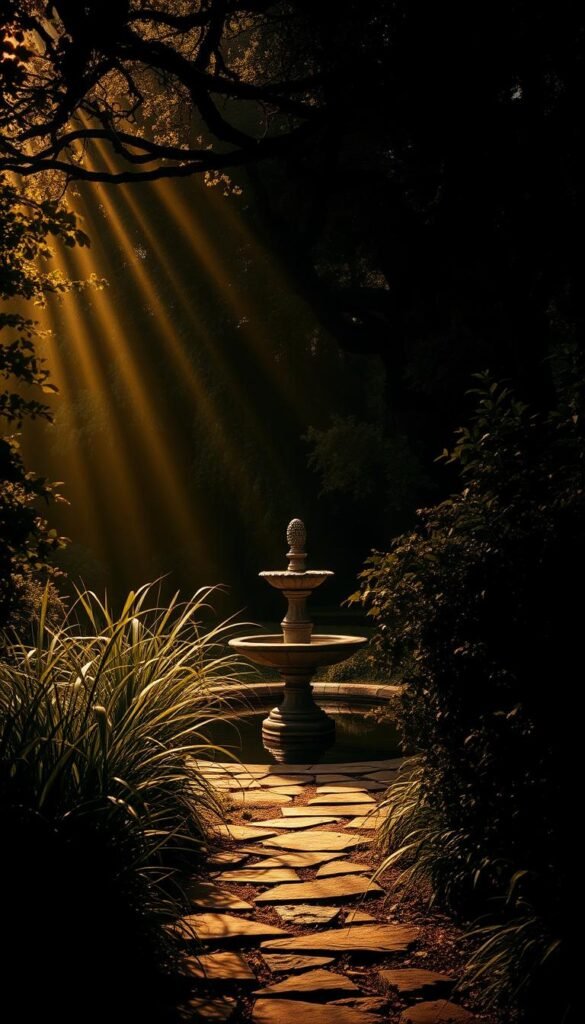Imagine transforming your outdoor space into a captivating retreat that whispers mystery. Across the U.S., a fresh trend is redefining what it means to connect with nature. Instead of bright blooms, gardeners are crafting shadowy sanctuaries using deep-toned foliage and strategic illumination.
This approach isn’t just about aesthetics—it’s a creative rebellion. In states like Colorado, where diverse climates nurture unique plants, these designs thrive. You’ll find midnight-hued heucheras, burgundy smoke bushes, and silvery Artemisia creating textured backdrops that shimmer under carefully placed lights.
Why does this style resonate? It offers a chance to break free from conventional garden norms. Your outdoor area becomes a canvas for self-expression, blending artistry with the raw beauty of the earth. Shadows aren’t something to avoid—they’re tools for crafting atmosphere.
Lighting plays a starring role here. Think downward-facing fixtures that mimic moonlight or pathway markers that guide without overpowering. The result? A space that feels both intimate and expansive, inviting quiet reflection or cozy gatherings.
This movement aligns with a cultural shift toward authenticity in design. Your experience with these concepts will challenge expectations while deepening your connection to the landscape. Ready to explore how shadows and subtlety can redefine your relationship with the outdoors?
Understanding the Dark Garden Aesthetic
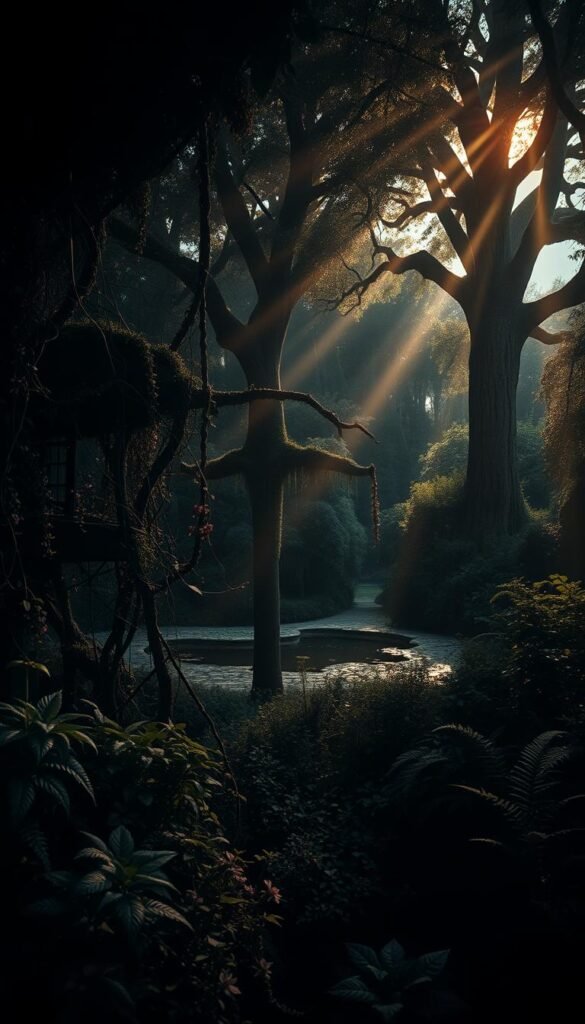
Step into a realm where deep shades and gentle light craft a serene escape. This design philosophy revolves around balancing bold colors with thoughtful illumination, turning ordinary yards into spaces brimming with mystery. Unlike vibrant flower beds, these palettes lean into twilight-inspired tones that invite curiosity.
Exploring Moody Colors and Their Impact
Rich burgundies, inky purples, and espresso browns form the backbone of this style. Plants like Ajuga reptans showcase leaves shifting from plum to bronze, pairing beautifully with their delicate blue blooms. This contrast between dark foliage and brighter accents adds layers of visual drama.
These hues create a calming effect, guiding the eye through textured arrangements. You’ll notice how chocolate-colored heucheras make silvery Artemisia pop, proving that depth thrives in subtlety. It’s not just about darkness—it’s about crafting intrigue through unexpected pairings.
The Role of Dramatic Lighting in Creating Ambiance
Strategic illumination transforms these spaces after sunset. Downward-facing lights mimic moonlight, casting soft shadows that highlight leaf textures. Pathway markers with warm glows guide footsteps without disrupting the mood.
By focusing light on specific plants or sculptures, you create focal points that shift with the evening breeze. This interplay between illumination and darkness turns your space into a living art piece. The world fades away as your garden becomes a stage for nature’s quiet drama.
Planning Your Garden Layout and Lighting Effects
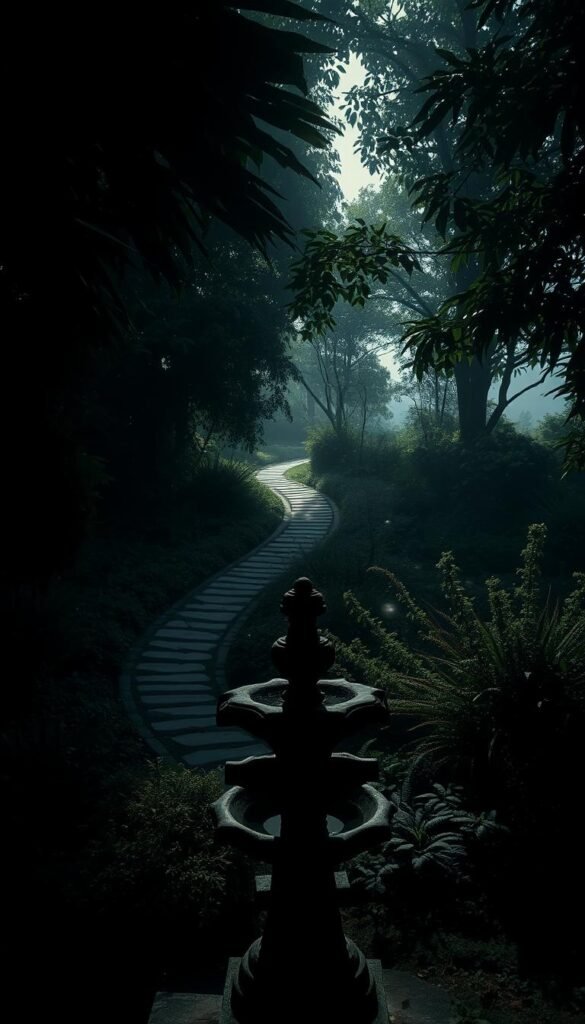
Creating an immersive outdoor experience starts with intentional design. Focus on flow and contrast to guide visitors through your landscape while maintaining a sense of mystery. Winding pathways using charcoal-gray cobblestones invite exploration, their irregular shapes catching subtle light after dusk.
Designing Outdoor Spaces for Maximum Impact
Start by mapping focal points that anchor your design. A weathered stone statue or cluster of jet-black elderberry bushes naturally draws the eye. Balance these bold elements with airy plants like maidenhair ferns to prevent visual heaviness.
Layer lighting at three levels for depth:
- Ground-level solar markers along paths
- Mid-height lanterns highlighting textured bark
- Overhead string lights filtering through tree canopies
Your space should transition smoothly from sunlit intrigue to moonlit drama. Consider how morning light plays off ebony mulches versus evening illumination from copper-toned fixtures. For those drawn to whimsical garden styles, blend rustic charm with shadowy sophistication using curved benches nestled among dark-leaved hostas.
Remember: effective layouts leave room for discovery. A partially obscured seating nook or unexpected reflection pool keeps the landscape feeling alive and layered. Test lighting placements at night, adjusting angles to create silhouettes that dance across your garden’s canvas.
Using Plants and Foliage to Create Moody Ambiance
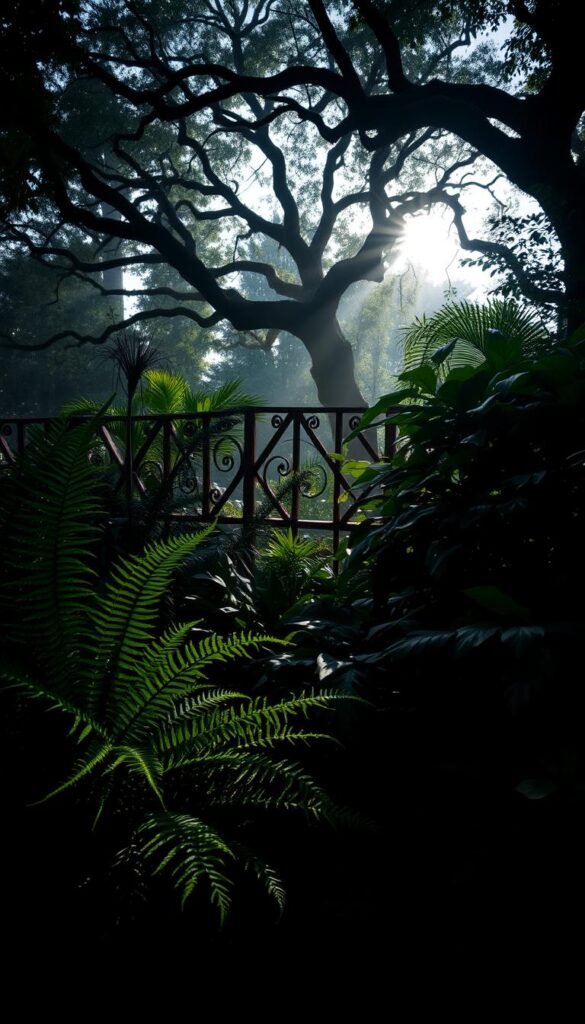
Transforming your landscape into a shadow-kissed masterpiece starts with the right botanical cast. These selections thrive in partial shade while contributing rich textures and unexpected depth to your outdoor theater.
Selecting the Right Dark Plants and Flowers
Black Tulips steal the show with velvet-like blooms that absorb sunlight dramatically. Pair them with Before the Storm Iris, whose near-black petals contrast beautifully against silvery Artemisia. For year-round intrigue, consider specialized seeds that yield Chocolate Ajuga’s crinkled bronze leaves or Thundercloud Plum’s purple canopy.
Edible options add functional flair. Dark Opal Basil offers fragrant purple leaves for cocktails, while Tuscan Kale’s blue-green frills make striking garnishes. Time your flowers like a pro: Lenten Roses bloom early, followed by summer’s Black Velvet Petunias, ensuring continuous color waves.
Caring for Your Dark Foliage and Unique Blooms
Most deep-hued plants need morning sun to intensify their pigments. Water Black Mondo Grass sparingly—its drought tolerance makes it perfect for rocky corners. Feed Dark-leaved Coral Bells monthly with iron-rich fertilizer to maintain their burgundy brilliance.
Prune Thundercloud Plum trees in late winter to showcase their branching patterns. For container varieties like Black Diamond begonias, use well-draining soil to prevent root rot. Remember: these botanical gems aren’t just about looks—their care routines become part of your garden’s living story.
Dark Garden Aesthetic: How to Embrace Moody Colors and Dramatic Lighting
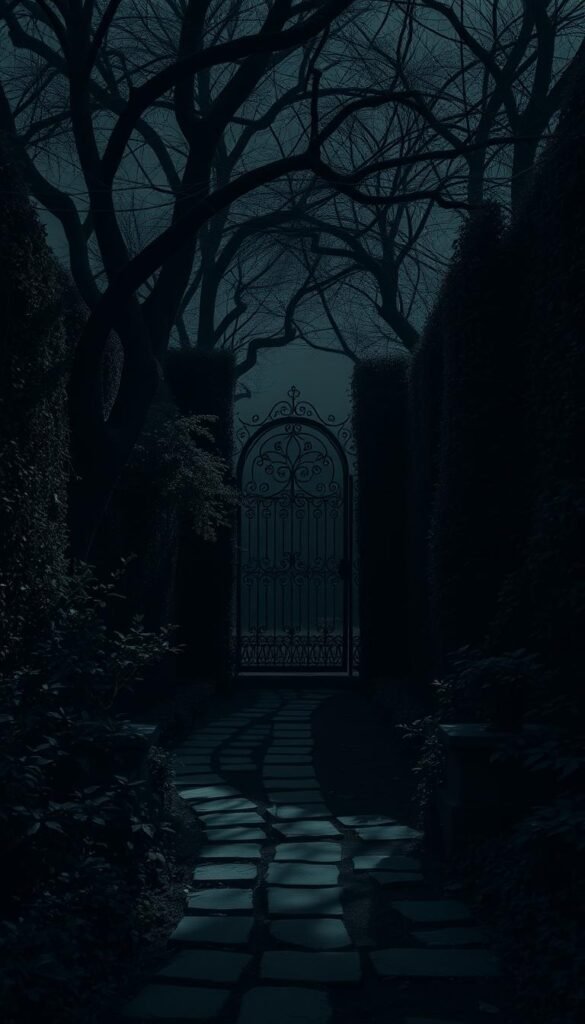
Crafting your shadow-inspired outdoor space requires methodical planning. Begin by sketching your vision while considering sunlight patterns and existing soil quality. This foundation ensures every choice supports your unique atmosphere.
Building Your Vision Layer by Layer
Start with soil testing—amend clay-heavy earth using compost for better drainage. In Colorado’s climate, drip irrigation systems conserve water while keeping roots healthy. Mark planting zones with charcoal mulch to enhance dark foliage contrast.
- Phase installations over seasons: plant hardy shrubs in fall, add lighting in spring
- Position downward-facing fixtures near textured bark or sculptural elements
- Document growth patterns monthly using a dedicated journal or app
Prune strategically—remove dead wood while preserving natural shapes. Rotate mulch every six weeks to deter pests and maintain moisture balance. These tips keep your design intentional yet adaptable.
Your space evolves into a living artwork as plants mature. Adjust lighting angles with the seasons to highlight new textures. This approach transforms maintenance into creative refinement, blending practicality with personal expression.
Through careful staging, your outdoor area becomes an extension of daily life. Evening strolls reveal shifting shadows, while morning light showcases dew-kissed leaves. Each thoughtful layer deepens your connection to the landscape’s quiet drama.
Incorporating Decor Elements and Stone Accents
Your outdoor sanctuary gains character through thoughtful accents that blend artistry with earthy materials. Strategic placement of these features enhances visual storytelling while adding tactile richness to every corner.
Adding Gothic Decorations and Wrought Iron Features
Statues like ravens or dragons inject playful mystery into your decor. Position them among ferns or near water features for unexpected discoveries. Wrought iron arches draped with climbing ivy frame views while supporting plant growth—a perfect marriage of form and function.
Choose furniture with intricate scrollwork to echo Victorian elegance. Plush cushions in deep emerald or wine hues invite lingering under string lights. These elements create focal points without overwhelming the senses.
Choosing the Perfect Stone Features for Texture and Depth
Slate stepping stones guide visitors through shadowy pathways, their uneven surfaces catching subtle light. Pair charcoal gravel with obsidian shards for sparkle under moonlight. Black lava rocks make striking borders around midnight-hued plants, amplifying their drama.
For added texture, layer basalt columns as natural sculptures. Their rough surfaces contrast beautifully with smooth-leaved hostas. These materials age gracefully, ensuring your space evolves with time while maintaining its haunting charm.
Ready to refine your approach? Explore creative ways to elevate your space through intentional material choices. Every stone and metal touch becomes part of your garden’s unfolding narrative.

